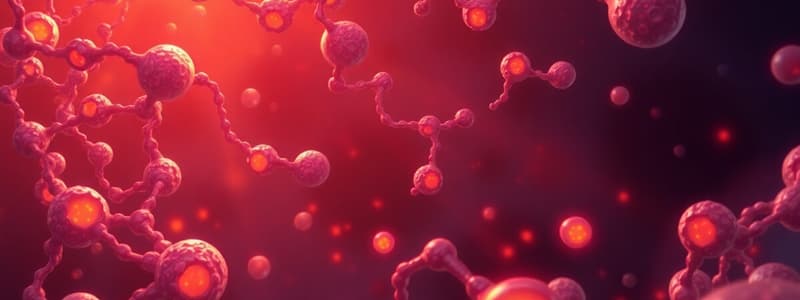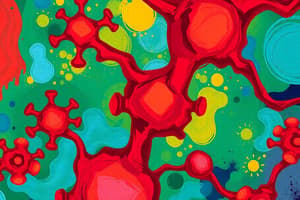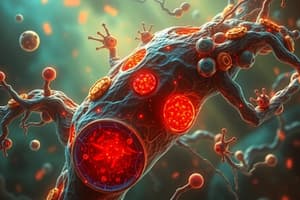Podcast
Questions and Answers
What is the primary action of NSAIDs in reducing inflammation?
What is the primary action of NSAIDs in reducing inflammation?
- Increasing the production of prostaglandins.
- Inhibiting the release of histamine.
- Decreasing the production of prostaglandins. (correct)
- Stimulating the immune system.
Which enzyme do immune cells use to produce arachidonic acid during inflammation?
Which enzyme do immune cells use to produce arachidonic acid during inflammation?
- Cyclooxygenase
- Phospholipase A2 (correct)
- Lipoxygenase
- Amylase
Which of the following is a constitutive enzyme?
Which of the following is a constitutive enzyme?
- COX-1 (correct)
- COX-3
- LOX
- COX-2
Which of the following is an effect of prostaglandin E2 (PGE2)?
Which of the following is an effect of prostaglandin E2 (PGE2)?
Which NSAID is known as an irreversible COX inhibitor?
Which NSAID is known as an irreversible COX inhibitor?
Where does most of the absorption of aspirin occur after oral administration?
Where does most of the absorption of aspirin occur after oral administration?
What is the effect of aspirin on platelets?
What is the effect of aspirin on platelets?
Which of the following is the active metabolite of aspirin?
Which of the following is the active metabolite of aspirin?
At what dose does aspirin primarily act as an antiplatelet medication?
At what dose does aspirin primarily act as an antiplatelet medication?
Which of the following is a non-selective COX inhibitor?
Which of the following is a non-selective COX inhibitor?
What effect does taking non-selective COX inhibitors with aspirin have on aspirin's antiplatelet effect?
What effect does taking non-selective COX inhibitors with aspirin have on aspirin's antiplatelet effect?
Which NSAID is used to close patent ductus arteriosus in neonates?
Which NSAID is used to close patent ductus arteriosus in neonates?
Which of the following is a selective COX-2 inhibitor?
Which of the following is a selective COX-2 inhibitor?
What is a potential gastrointestinal side effect of non-selective COX inhibitors?
What is a potential gastrointestinal side effect of non-selective COX inhibitors?
How do NSAIDs affect renal blood flow?
How do NSAIDs affect renal blood flow?
What system in the body can be activated by decreased renal blood flow due to NSAIDs?
What system in the body can be activated by decreased renal blood flow due to NSAIDs?
What is a possible side effect of NSAID use in the kidneys, especially with chronic abuse?
What is a possible side effect of NSAID use in the kidneys, especially with chronic abuse?
If someone experiences hypersensitivity to one NSAID, what is likely to occur when taking other NSAIDs?
If someone experiences hypersensitivity to one NSAID, what is likely to occur when taking other NSAIDs?
What condition is characterized by nasal polyps, asthma, and NSAID hypersensitivity?
What condition is characterized by nasal polyps, asthma, and NSAID hypersensitivity?
Why should aspirin be avoided in children with viral infections?
Why should aspirin be avoided in children with viral infections?
What are early symptoms of salicylate poisoning?
What are early symptoms of salicylate poisoning?
What effect does high-dose salicylate have on the respiratory center?
What effect does high-dose salicylate have on the respiratory center?
How does salicylate affect oxidative phosphorylation at high doses?
How does salicylate affect oxidative phosphorylation at high doses?
What causes seizures or coma in aspirin overdose?
What causes seizures or coma in aspirin overdose?
Which of the following is a treatment for aspirin overdose?
Which of the following is a treatment for aspirin overdose?
Flashcards
NSAIDs
NSAIDs
Drugs used to treat inflammation, pain, and fever by reducing prostaglandin production.
Inflammation
Inflammation
The body's response to harmful stimuli like infection or injury.
Phospholipase A2
Phospholipase A2
Enzyme that uses membrane phospholipids to make arachidonic acid during inflammation.
Arachidonic Acid
Arachidonic Acid
Signup and view all the flashcards
Cyclooxygenase (COX)
Cyclooxygenase (COX)
Signup and view all the flashcards
COX-1
COX-1
Signup and view all the flashcards
COX-2
COX-2
Signup and view all the flashcards
Prostaglandins
Prostaglandins
Signup and view all the flashcards
Nociceptors
Nociceptors
Signup and view all the flashcards
Aspirin
Aspirin
Signup and view all the flashcards
Aspirin's Antiplatelet Effect
Aspirin's Antiplatelet Effect
Signup and view all the flashcards
Salicylate
Salicylate
Signup and view all the flashcards
Non-Selective COX Inhibitors
Non-Selective COX Inhibitors
Signup and view all the flashcards
Selective COX-2 Inhibitors
Selective COX-2 Inhibitors
Signup and view all the flashcards
GI Side Effects of NSAIDs
GI Side Effects of NSAIDs
Signup and view all the flashcards
NSAIDs and Kidney Function
NSAIDs and Kidney Function
Signup and view all the flashcards
Reye's Syndrome
Reye's Syndrome
Signup and view all the flashcards
Samter’s Triad
Samter’s Triad
Signup and view all the flashcards
Aspirin Poisoning Symptoms
Aspirin Poisoning Symptoms
Signup and view all the flashcards
Anion Gap Metabolic Acidosis
Anion Gap Metabolic Acidosis
Signup and view all the flashcards
Aspirin Overdose Treatment
Aspirin Overdose Treatment
Signup and view all the flashcards
Study Notes
- Non-steroidal anti-inflammatory drugs (NSAIDs) are used to treat inflammation, pain, and fever by decreasing the production of prostaglandins.
- Prostaglandins are pro-inflammatory chemicals.
Inflammation and Arachidonic Acid
- Inflammation is the body’s response to a harmful stimulus like infection or injury.
- Immune cells use phospholipase A2 to convert membrane phospholipids into arachidonic acid during inflammation.
- Arachidonic acid is a 20-carbon polyunsaturated fatty acid.
- Arachidonic acid is a substrate for cyclooxygenase (COX).
Cyclooxygenase (COX) Isoforms
- COX exists in two isoforms: COX-1 and COX-2.
- COX-1 is a constitutive enzyme, always active.
- COX-2 is an inducible enzyme, activated by immune cells and vascular endothelial cells during inflammation.
Prostaglandin Production
- Both COX-1 and COX-2 produce prostaglandin E2 (PGE2) and prostacyclin (PGI2).
- PGE2 and PGI2 cause vasodilation and attract immune cells to the affected area.
- These prostaglandins act on nociceptors (pain-detecting neurons), increasing their sensitivity by lowering their activation threshold.
- They stimulate the hypothalamus to increase body temperature, causing fever.
- Prostaglandin E2 causes uterine contractions, decreases acid secretion, and increases protective mucus production in the stomach.
NSAID Groups
- NSAIDs inhibit cyclooxygenase to decrease prostaglandin production.
- NSAIDs are subdivided into irreversible COX inhibitors (aspirin) and reversible COX inhibitors (non-aspirin NSAIDs).
- Non-aspirin NSAIDs are further divided into non-selective COX inhibitors (ibuprofen) and selective COX-2 inhibitors (celecoxib).
Aspirin (Acetylsalicylic Acid)
- Aspirin works by irreversibly inhibiting both COX-1 and COX-2.
- Aspirin is mainly absorbed in the ileum, after peroral intake.
- Aspirin irreversibly inhibits COX-1 in platelets through covalent acetylation, decreasing thromboxane A2 production.
- Aspirin's effects persist until new platelets are produced due to irreversible COX-1 inhibition and increases bleeding time.
- In the liver, aspirin is metabolized into salicylate, which has anti-inflammatory properties but no antiplatelet effect.
- Salicylate inhibits COX-2, reducing prostaglandin production and decreasing inflammation, pain, and fever.
- Salicylate is used for headaches, musculoskeletal pain, osteoarthritis, rheumatoid arthritis, and ankylosing spondylitis.
Aspirin Dosage
- Low doses (under 300 mg/day) of aspirin work as an antiplatelet medication.
- Medium doses (300-2400 mg/day) of aspirin work as an antipyretic and analgesic.
- High doses (over 2400 mg/day) of aspirin work as an anti-inflammatory medication.
- Low-dose aspirin (81 mg) is used long-term to prevent heart attacks, strokes, and blood clot formation.
Non-Selective COX Inhibitors
- Non-selective COX inhibitors reversibly inhibit both COX-1 and COX-2.
- Common medications include ibuprofen, naproxen, ketorolac, indomethacin, sulindac, and meloxicam.
- Ketorolac, ibuprofen, and indomethacin are available in parenteral form.
- These medications inhibit COX-1 and have a temporary antiplatelet effect.
- They compete with aspirin for binding sites on COX-1, reducing aspirin’s antiplatelet effect.
- Non-selective COX inhibitors also inhibit COX-2, reducing inflammation, pain, and fever.
Specific Uses of Non-Selective COX Inhibitors
- Ibuprofen, naproxen, and indomethacin reduce inflammation during acute gout attacks.
- Aspirin is avoided during gout attacks because it competes with uric acid for excretion.
- Indomethacin is used to close patent ductus arteriosus in neonates and premature infants.
- Ketorolac is used to treat severe acute pain, usually after surgery.
Selective COX-2 Inhibitors
- Celecoxib is the main medication in this group.
- Celecoxib reversibly inhibits COX-2, treating pain and inflammation.
- Celecoxib lacks the antiplatelet effect seen in aspirin.
- Celecoxib doesn’t compete with aspirin for COX-1, so they can be combined without decreasing aspirin's antiplatelet effect.
Side Effects of NSAIDs
- Aspirin and nonselective COX inhibitors can cause gastric issues by blocking COX-1 in the stomach.
- Inhibition of COX-1 leads to decreased cytoprotective prostaglandins, which can result in gastritis, ulcers, or bleeding.
- Reversible inhibitors of COX-1 cause fewer gastrointestinal problems than aspirin.
- Selective COX-2 inhibitors like celecoxib cause the least GI side effects.
- All NSAIDs inhibit COX-2 in the kidneys, decreasing prostaglandins that dilate the renal artery and reducing renal blood flow.
- Reduced renal blood flow activates the renin-angiotensin-aldosterone system, leading to hypertension.
- Low doses of aspirin can lower blood pressure if taken before bedtime, but high doses increase blood pressure.
- Reduced kidney blood flow can lead to acute kidney injury, especially in the elderly and those with heart, liver, or kidney disease.
- Chronic NSAID abuse can lead to analgesic nephropathy, manifesting as chronic nephritis or renal papillary necrosis.
- Hypersensitivity reactions, such as Stevens-Johnson Syndrome, toxic epidermal necrolysis, and anaphylactic reactions may occur.
- Cross-hypersensitivity means that individuals hypersensitive to one NSAID may react to others.
- People with nasal polyps and asthma are more likely to experience NSAID hypersensitivity, which is known as Samter’s triad or aspirin exacerbated respiratory disease.
Aspirin-Specific Side Effects
- Aspirin should not be given to children with viral infections due to the risk of Reye’s syndrome.
- Reye’s syndrome is characterized by liver damage and encephalopathy.
- Aspirin can be used in children to reduce fever in Kawasaki’s disease.
- An aspirin overdose can be fatal.
- Early symptoms of salicylate poisoning include tinnitus, deafness, headache, and vomiting.
- High doses of salicylate directly stimulate the respiratory center, causing hyperventilation and respiratory alkalosis.
- Increased salicylate doses inhibit oxidative phosphorylation, leading to anaerobic metabolism and lactic acid production.
- Lactic acid buildup causes an elevated anion gap metabolic acidosis.
- Decreased blood pH causes more salicylate to convert to its non-ionized form (salicylic acid), which crosses the blood-brain barrier and causes seizures or coma.
Treatment for Aspirin Overdose
- There is no specific antidote for aspirin overdose.
- Treatment includes administration of activated charcoal to prevent absorption.
- Alkalization of urine using sodium bicarbonate facilitates salicylate excretion.
- Ventilatory support and management of acid-base imbalance are also required.
Studying That Suits You
Use AI to generate personalized quizzes and flashcards to suit your learning preferences.




